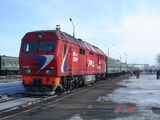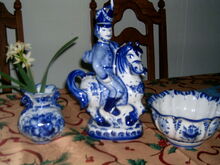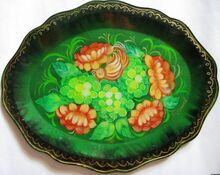| Moscow Oblast Московская область |
|||
|---|---|---|---|
| — Federal Subject of Russia — | |||
| The southern part of the Moscow Canal | |||
|
|||
| Coordinates: Coordinates: | |||
| Country | Russia | ||
| Political status | Oblast | ||
| Federal District | Central | ||
| Economic Region | Central | ||
| Official language | Russian | ||
| Established | January 14, 1929 | ||
| Administrative center | According to Article 24 of the Charter of Moscow Oblast, the government bodies of the oblast are located in the city of Moscow and throughout the territory of Moscow Oblast. However, Moscow is not the official administrative center of the oblast.</ | ||
| Government | |||
| • Type | Legislature | ||
| • Body | Oblast Duma | ||
| • Governor | Boris Gromov | ||
| Area | |||
| • Federal Subject of Russia | 45,900 km2 (17,700 sq mi) | ||
| Area rank | 54th | ||
| Population (2010) | |||
| • Federal Subject of Russia | 7,092,900 | ||
| • Rank | 2nd | ||
| • Urban | 80.1% | ||
| • Rural | 19.9% | ||
| ISO 3166 code | RU-MOS | ||
| Vehicle registration | 50, 90, 150, 190 | ||
| Website | http://www.mosreg.ru | ||
Moscow Oblast (Russian: Моско́вская о́бласть, Moskovskaya Oblast), or Podmoskovye (Подмоско́вье), is a federal subject of Russia (an oblast). Its area, at 45,900 km2 (17,700 sq mi), is relatively small compared to other federal subjects, but it is one of the most densely populated regions in the country[1] and, with the 2002 population of 6,618,538, is the second most populous federal subject. There is no official administrative center of Moscow Oblast; its public authorities are located in Moscow and Krasnogorsk.
Geography[]
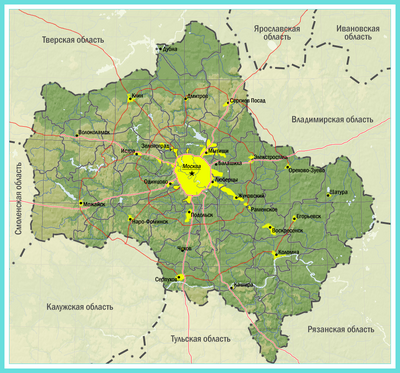
Map of Moscow region
Relief[]
The region is mostly flat, with some hills with the height of about 160 m (520 ft) in the western and extensive lowlands in the eastern part. From the south-west to north-east, the region is crossed by the border of the Moscow glacier to the north of the common ice-erosion form with moraine ridges, and to the south – only erosional landforms. The western and northern parts of the oblast contain the Moscow Uplands. Their average height peaks at about 300 m (980 ft) near Dmitrov and the upper point of 310 m (1,020 ft) lies near the village of Shapkino of Mozhaysk District. The northern part of the Moscow Uplands is steeper than the southern part. The uplands contain lakes of glacial origin, such as Nerskoe and Krugloe lakes. To the north of the Moscow Uplands lies the alluvial Verhnevolzhsk Depression. It is marshy and flat with the height varying between about 120 m (390 ft) and 150 m (490 ft). [2]
Geology and minerals[]
Geology[]
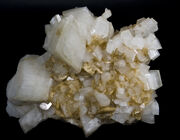
Dolomite

Marl
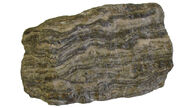
Gneiss
Moscow Oblast is located in the central part of the East European craton. Like all cratons, the latter is composed of the crystalline basement and sedimentary cover. The basement consists of Archaean and Proterozoic rocks and the cover is deposited in the Palaeozoic, Mesozoic and Cenozoic eras. The lowest depth of the basement (1,000 m (3,300 ft)) is to the south of Serebryanye Prudy, in the very south area of the oblast, and the largest (4,200 m (13,800 ft) m) is to the east of Sergiyev Posad, in the north-east region.[3]
Tertiary deposits are almost absent within the oblast. Significantly more abundant are deposits of the Carboniferous and Jurassic periods. In the Cretaceous period, a sea was covering the Moscow Oblast, as evidenced by phosphate deposits and a variety of sands. Cretaceous sediments are most common in the north of the oblast. The sea was wider in Jurassic than in Cretaceous period. Typical Jurassic deposits, in the form of black clay, are found within and around the Moscow city and in the valley of the Moscow River. Carboniferous deposits in Moscow Oblast are represented by dolomite, limestone and marl. Coal deposits rich in organic remains occur in the south, especially in Serpukhov District, and in the west regions. Devonian deposits were also found within the region.[4]
Quaternary deposits are widely distributed in the Moscow Oblast, their thickness decreases from the north-west to south-east. It is believed[5] that there were four glaciations in the area. The first occurred in the Lower Pleistocene and spread to the east-west part of the Oka River valley, it left almost no trace in the region. In the Middle Pleistocene, there were two powerful glaciations. The Dnieper glacier covered a large part of the Russian Plain), whereas the Moscow glaciation stopped just south of the present Moscow city. The last glaciation, Valdai glaciation, occurred in the Late Pleistocene; it did not directly affect the territory of Moscow Oblast, but left traces in the form of fluvioglacial deposits, mainly in the north area. The glaciers left behind a moraine loam with pebbles and boulders of various rocks, such as granite, gneiss, quartzite, dolomite, limestone and sandstone. Its thickness varies between a few meters at watersheds and 100 m at moraine ridges.[6]
Minerals[]
Moscow Oblast is rich in minerals. Sands from the sediments of different periods (mainly Quaternary and Cretaceous) are of high quality and are widely used in construction. Quartz sand (milled quartz) is used in the glass industry, their production is conducted from the end of 17th century near Lyubertsy. Much of the production is currently halted due to environmental concerns, and only the Eganovskoe field is being exploited; its silica sand reserves are 33 million tonnes and annual production reaches 675,000 tonnes.[7] Sand and gravel deposits are abundant within the Smolensk-Moscow Upland. Sandstone deposits are developed in the Klin and Dmitrov districts.
There are numerous clay deposits within the Moscow Oblast, fusible clay is excavated in Sergiyev Posad. The Eldiginskoe field near the village of Sofrino has reserves estimated at 30 million cubic meters, its annual production reaches 600,000 m3 (21,000,000 cu ft). Refractory white clay occurs in the eastern region, in the Carboniferous and Jurassic sediments, and is extracted from the 14th century near Gzhel. The largest (Kudinovskoe) deposit is near the town of Elektrougli with the reserves of 3 billion tonnes. Also widespread are loams which are used in brick manufacture and limestones ("white stone"). The famous Myachkovo deposit of carboniferous limestone provided material which went for cladding of such buildings in Moscow as Bolshoi Theatre. The mining in Myachkovo had been stopped and currently, limestone is provided by the quarries of Podolsk, Voskresensk and Kolomensky Districts. The last district also provides marble-like limestone.[8]
Other industrial mineral of Moscow Oblast is dolomite, limestone tuff and marl, mostly in the southern and eastern parts. Dolomite is used in the cement industry. Its mining is concentrated mainly near Schelkovo, the reserves exceed 20 million tonnes and the annual production is about 650 tonnes.[9]
Phosphates are produced in the Yegorevskoe and Severskoe fields. Meshchera and Verkhnevolzhsk Lowlands are rich in peat. The largest mines are "Ryazanovskoe" (840,000 tonnes per year) and "Radovitsky moss" (760,000 tonnes per year), both in Yegoryevsk area.[10][11] There are deposits of brown coal beyond the Oka River, but they have no commercial value. There are also minor deposits of titanium and iron ore in Serpukhov and Serebryano-Prudsky districts.
Salts of potassium salt are being developed in Serpukhov and Yegoryevsk areas. There are also numerous mineral springs near Zvenigorod, Klin and Serpukhov. They include surface springs and reservoirs at the depth of 300-500 m. Deeper, at 1-1.5 km there is a large sea of salt extending beyond the Moscow Oblast. Waters with the salt concentration up to 300 g/l are used in the local food industry and spas.
Climate[]
The climate of Moscow Oblast is temperate continental, with clearly expressed seasonality – hot summers and cold winters; the continentality increases from north-west to south-east. The period of the average temperature below 00C lasts 120–135 days, beginning in mid-November and ending in late March. The average annual temperature varies from 3.5 °C (38.3 °F) to 5.5 °C (41.9 °F). The coldest month is January with the average temperature of −8 °C (17.6 °F) in the west and −10 °C (14.0 °F) in the east. With the arrival of arctic air, the temperature drops to below −20 °C (−4.0 °F) that may last up to 20 days during the winter, with the temperatures reaching −45 °C (−49.0 °F). The minimum temperature of −54 °C (−65.2 °F) was observed in Naro-Fominsk. Thaws often occur in December and February due to the Atlantic, and rarely the Mediterranean cyclones. The thaws usually last several days, and their total number from November to March can reach fifty. Snow starts accumulating in November, though sometimes in September or December, and disappears in mid-April (sometimes in late March). The snow depth is 25-50 cm and the soil freezes to 65-75 cm. The warmest month is July with the average temperature of 18.5 °C in the west and 20.0 °C in the south-east. The maximum temperature of 40 °C was recorded in Kolomna during 2010 European heat wave. The average annual rainfall is 450-650 mm, the precipitation is maximal in the north-western and minimal in the south-east regions. The summer precipitation is usually 75 mm, but severe droughts occur once in 25–30 years, with less than 5 mm of rain over June–August. [12]
Rivers and lakes[]
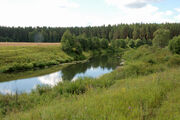
Shosha River near Mikulino village
There are more than 300 rivers with the length above 10 km (6.2 mi) in Moscow Oblast. All rivers are calm and have well-developed valleys and floodplains. They are mostly fed by melting snow and the flood falls on April–May. The water level is low in summer and increases only with heavy rain. The rivers freeze over from late November until mid-April. The only navigable rivers are the Volga, the Oka and Moskva River.
Most rivers belong to the basin of the Volga, which itself only crosses a small part in the north of Moscow Oblast, near the border with Tver Oblast. The second largest river of the region is Oka. The northern part of Moscow Oblast includes such Volga tributaries as Shosha, Lama, Dubna, Sestra and Yakhroma. On the south flow the tributaries of Oka, including Nara, Protva and Lopasnya River. The Moscow River, which almost entirely flows within the oblast, also belongs to the Oka basin. The eastern and north-eastern regions, including much of Meschersk Depression, are irrigated by the tributaries of the Klyazma River, which itself is a main tributary of the Oka.
The Moscow Canal crosses the northern part of Moscow Oblast through the Ikshinskoe, Klyazminskoe, Pyalovskoe and Pestovskoye reservoirs. In the basin of the Moscow River, there are also Ozerninskoe, Mozhayskoe, Istrinskoe and Ruza reservoirs, providing the Moscow city with drinking water.
There are about 350 lakes in the oblast, almost all are shallow (5–10 m) and many are of glacial origin. The largest are Senezh (15.4 km2 (5.9 sq mi)) and Svyatoe (12.6 km2 (4.9 sq mi)) whereas the deepest (32 m (105 ft)) is Glubokoye Lake in the Ruza district. There are also many marshes, especially within the Meshchersk and Verkhnevolzhsk lowlands.
Soils[]
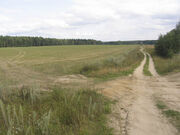
A typical landscape of Moscow Oblast
The region is dominated by relatively infertile podsol soils which require fertilizers for commercial agriculture. On the hills there is more loam and the low-lying areas have more of bog, sandy loam and sand. Chernozem is scarce and occurs only south of the Oka River. Gray forest soils are spread between the Oka, Moscow and Klyazma rivers, mostly in the Ramensky and Voskresensky districts. Marshy soils are common in Meshchersk and Verkhnevolzhsk lowlands. Valleys of large rivers are rich in alluvial soils. In general, soils of the Moscow Oblast are heavily polluted with chemical fertilizers, pesticides, and household and industrial waste, especially around Moscow, Orekhovo-Zuyevo, Noginsk and Voskresensk.
Flora[]
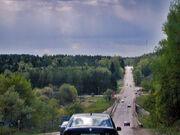
The small highway ring around Moscow
Moscow Oblast lies within the zone of forests and steppes with forests covering over 40% of the region. Coniferous (mainly fir) trees dominate the northern (Verkhnevolzhsk lowlands) and western parts (Mozhaysk, Lotoshinsk and Shakhovsky districts). Forests of Meshchora consist primarily of pine; in waterlogged lowlands, there are individual alder forests. Central and eastern regions have coniferous-deciduous forests with the main tree species of spruce, pine, birch and aspen often mixed with bushes of hazel. To the south lies the subzone of broad-leaved forests of oak, lime, maple and elm. Moscow-Oka Upland is the transition zone which is dominated by spruce, for example, in the upper reaches of the Lopasnya River. Valleys of Oka are covered in pine forests of the steppe type and the far south regions (Serebryano-Prudsky and partially Serpukhov Districts) are cultivated steppes with occasional lime and oak groves.[13]
The intensive cutting of Moscow region forests in the 18–19th centuries reduced them and changed their species: conifers were replaced by birch and aspen. There is almost no logging nowadays and the forests are being restored, especially around Moscow. Swamps are prevalent in the eastern areas, such as Shatura and Lukhovitsy. The natural floodplain meadows are almost gone. The number of native plant species is reduced, but some foreign species flourish, such as Canadian maple. Endemic species include water caltrop and lady's slipper.
Fauna[]
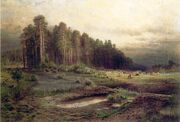
Losiny Ostrov park, painting by Alexei Savrasov
The mammals of the Moscow Oblast include badger, squirrel, beaver, otter, muskrat, stoat, Russian Desman, raccoon dog, hedgehog, hare (Mountain and European), shrews (Common Shrew, Eurasian Pygmy Shrew, Lesser White-toothed Shrew, Eurasian Water Shrew, etc.), weasel, fox, moose, wild boar, European Mole, brown and black rats, marten, mice and voles (Wood mouse, Yellow-necked Mouse, house mouse, Harvest Mouse, Northern Birch Mouse, Bank Vole, Field Vole, Tundra Vole, European Water Vole), European Mink, deer (roe, red, spotted),
hazel and fat dormouse, European Polecat. At the borders there are occasional bears, lynxes and wolves. In the southern areas there are also speckled ground squirrel, dwarf hamster, Great Jerboa and Beech Marten. Some areas contain stable populations of imported animals, such as flying squirrel, American mink and Siberian Roe Deer. In the Moscow region, there are more than a dozen kinds of bat
and moth. [14]
There are more than 170 species of birds in the area with large numbers of crows, sparrows, ducks, magpies, woodpeckers, thrushes, grouses, bullfinches, nightingales, corncrakes, Northern Lapwings, White Storks, Grey Herons, seagulls and grebes. Over forty species are being hunted. [14]
Rivers and lakes of Moscow Oblast are rich in fish, such as ruff, carp, bream, bass, roaches, Chinese sleeper, perch and pike. There are six species of reptiles: three lizards (slow worm, Viviparous lizard and Sand Lizard) and three snakes (European adder, Grass Snake and smooth snake). There is evidence for bog turtles in some areas. Amphibians are represented by 11 species including Smooth Newt, Great Crested Newt, common toad, European Green Toad, Common Frog, Moor Frog, Marsh Frog, Common Spadefoot and European Fire-bellied Toad. Insects are numerous, with only bees accounting for more than 300 species.[14]
In Serpukhov District, there is the Prioksko-Terrasny Nature Reserve which contains protected wisents. Near Moscow lies Losiny Ostrov National Park of federal significance.

|

|

|

|

|

|
| Roe Deer fawn | Harvest mouse | Great Crested Grebe |
History[]
The territory of the Moscow Oblast had been inhabited for more than twenty thousand years. Numerous mounds and settlements from Iron Age were discovered there. Up to the 9–10th centuries, the Moscow River basin and adjacent lands were inhabited by Finno-Ugric peoples. Slavs populated the area only in the 10th century. In mid-12th century, the lands of Moscow Oblast became part of Vladimir-Suzdal principality. Several importance cities were founded around that time, including Volokolamsk (1135), Moscow (1147), Zvenigorod (1152) and Dmitrov (1154). In the first half of the 13th century, the entire Vladimir-Suzdal Principality, including the Moscow area, was conquered by the Mongols.[15]
In the 13th century, the land around Moscow was part of Grand Duchy of Moscow, which subsequently was the center of the unification of Russian lands, in particular the Mongol raids. In 1380, from Kolomna the prince Dmitry Donskoy led his troops to defeat the Mongols at the Battle of Kulikovo. The southern part of Moscow Oblast was then part of the Principality of Ryazan; it was attached to Moscow only in the 1520.[16]

Fragment of the panorama of the Battle of Borodino by Franz Roubaud (1912)
In 1708, Moscow Governorate was established by the decree of Peter I, the area included most of the present Moscow Oblast. The Battle of Borodino, which decided the outcome of the French invasion of Russia was fought in 1812 near Mozhaysk.
Industries developed in Moscow Oblast in the 17–19th centuries. They were centered in Bogorodsk, Pavlovsky Posad, and Orekhovo-Zuyevo and were dominated by textile production. The first railway in Russia was constructed in the Moscow Oblast in 1851, connecting Moscow and Saint Petersburg, and in 1862 the line to Nizhny Novgorod was opened.
Central Industrial Oblast was established by the All-Russian Central Executive Committee on 14 January 1929. It included the abolished Moscow, Ryazan, Tver, Tula, Vladimir, and Kaluga Governorates. The oblast was divided into ten okrugs and had the administrative center in Moscow. On 3 June 1929, the oblast was renamed Moscow Oblast and on 30 July 1930, the division into ten okrugs was abolished.[17][18]
Parts of the then bulky Moscow Oblast were gradually transferred to other divisions. In particular, 26 districts became part of Kalinin Oblast in January 1935, and another 77 districts were separated in September 1937 as Tula and Ryazan Oblasts. Borovsky, Vysokinichsky, Maloyaroslavetsky, Ugodsko-Zavodsky, and Petushinsky Districts were transferred in 1944 to Kaluga and Vladimir Oblasts.[17][18]
In 1941–1942, one of the most significant military operations of World War II – the Battle of Moscow was fought in the Moscow Oblast.
According to the Constitution of Russia, adopted in December 1993, Moscow Oblast is one of the 83 federal subjects of Russia.
Economy[]
Industry[]
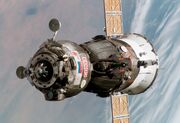
Soyuz-TMA-6 spacecraft developed by Energia
In terms of industrial production, Moscow Oblast is second in Russia, after the Moscow city. The industry of the Oblast relies on imported raw materials, strong scientific and technological base and highly skilled workforce; it is closely linked with the industry of Moscow.
Well developed are machinery and metalworking. There are plants for the thermal and nuclear power engineering (ZiO-Podolsk in Podolsk), nuclear fuel (TVEL in Elektrostal), space and missile (Energia in Korolyov, Lavochkin in Khimki, NGO engineering in Reutov, FTSDT "Union" in Dzerzhinsky – development of solid rocket fuel, etc., IBC "Horizon" in Dzerzhinsky – power plants for aircraft, etc.); locomotives (Kolomna factory), metro cars (Metrowagonmash in Mytischi), electric trains (Demikhovsky Engineering Works), cars (SeAZ), buses (Likinsky bus plant in Likino-Dulyovo); agricultural machines, excavators and cranes (Lyubertsy, Dmitrov, Balashikha); stainless steel (Elektrostal), cables (Podolsk), optical devices (Krasnogorsky plant, Lytkarino Optical Glass Factory).
There are many defense enterprises, such as Russian Center for demonstrations of weapons, military equipment and technology in Krasnoarmeysk; Kamov, Phazotron, Bazalt, NPP Zvezda, MKB Fakel, MKB Raduga, National Research Institute of Aviation Systems, Krasnozavodsk Chemical Plant, Tikhomirov Scientific Research Institute of Instrument Design, Moscow Research Institute "Agat", Dolgoprudnenskoe Scientific Production Plant, and many others.
Chemical industry of the Oblast produces acids (Shchyolkovo), mineral fertilizers (plants named "Phosphates" and "Mineral fertilizers" in Voskresensk), synthetic fibers (Serpukhov and Klin), plastics (Orekhovo-Zuyevo), varnishes and paints (Sergiyev Posad, Odintsovsky paint factories), pharmaceuticals (Staraya Kupavna). There is a well-deeloped industry of construction materials with production of cement in Voskresensk and Kolomna (Shchurovsky cement factory), earthenware, porcelain in the Likino-Dulyovo (Dulevo Porcelain Factory) and Verbilki and dry mortar plant in Krasnogorsk.
Light industry is the oldest in the region; it was started in the 17th century and with 35% contribution was leading the gross industrial production. There is still production of cotton (in Yegoryevsk, Noginsk, Orekhovo-Zuyevo), wool (in Pavlovsky Posad and Pushkin) and jerseys (in Ivanteyevka and Dmitrov). The silk production in Naro-Fominsk had been stopped. Traditional and renowned crafts include Gzhel, Zhostovo painting and Fedoskino miniature. Large foreign investment projects include the plant for manufacturing household appliances (TV sets, washing machines, refrigerators, etc.) by the South Korean company LG built near the village of Dorokhovo.[19]
Energy[]
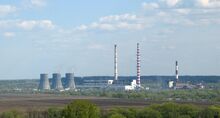
The largest source of electricity in the Moscow region – Kashirskaya thermal power plant
In 1999, Moscow Oblast consumed 15.4 billion m³ of natural gas, 3.32 million tonnes of oil, 2.13 million tonnes of coal and 8.5 billion kWh of electricity. Electricity for the Oblast is provided by the Kashirskaya thermal power plant (TPP, 1910 MW), Dzerzhynskaya TPP No 22 (1300 MW), TPP-27 (1100 MW), Shatura Power Station (1100 MW), Zagorskaya hydroelectric power plant (1200 MW), Elektrogorsk TPP (623 MW) and several smaller plants. Major new energy project in the region is the construction of Zagorsk hydroelectric plant with the capacity of 840 MW. The deficit of energy is provided by powerlines connecting the region with Saint Petersburg, Volga Hydroelectric Station and other energy suppliers.[20]
Agriculture[]
Agriculture has a relatively minor role in the economy of the Oblast. Only 25% of land is cultivated and another 15% are used for other activities such as livestock farming. Agriculture is the least developed in the northern, eastern and western border regions. In the southern region, especially south of the Oka River, more than 50% of land is used in agriculture. Horticulture is typical for the southern region with most of the sown area (more than 3/5) occupied by forage crops. Large areas are reserved for grains, especially wheat, barley, oats and rye, and significant role plays potato. Greenhouses are very common and Moskovsky city hosts the largest greenhouse complex in Europe. Also grown are flowers and mushrooms. Livestock farming predominates over the crop, and is primarily aimed at the production of milk and meat. In addition to cattle, commonly bred are pigs and chickens.
The economic crisis of 1990s in Russia had severely affected the agriculture of Moscow Oblast. In particular, in the 2000s, as compared with 1970–80s, the grain production has fallen by more than 3 times; potatoes by 2.5 times; vegetables, livestock and poultry by 30%; milk by 2 times and eggs by 4 times.[21][22]
Transport[]

The gateway to the Moscow Canal in Yakhroma

Moscow's North River Terminal or Rechnoy Vokzal
Moscow Oblast has a dense transport network, including roads, railways and waterways along the largest rivers, lakes and reservoirs. Land routes are radially diverging from Moscow and crossed by one railway and two highway rings. Neither railways nor roads, built for the most part many years ago, can cope with the steadily mounting traffic flows. About half of the roads are overloaded and three quarters do not meet modern requirements. Insufficient width of the roads and frequent repairs cause traffic jams.[23]
Moscow Oblast has the highest density of railways in Russia. Eleven major radial lines originate in Moscow and run through the Oblast; the total length of the railways reaches 2,700 km. Almost all railroads are electrified. The largest rail hubs are Orekhovo-Zuyevo and Bekasovo. Regular navigation is carried on the rivers Volga, Oka and Moscow, as well as on the Moscow Canal. Major river ports are in Serpukhov and Kolomna. Also well-developed is pipeline transport. There are two major oil lines, two natural gas rings and numerous radial lines connecting Moscow with the largest gas producing regions of the country.[24]
Moscow and Moscow Oblast have several international passenger airports, namely Sheremetyevo (with two terminals), Vnukovo, Domodedovo and Ostafyevo. Airport Bykovo is currently used for freight. The largest military airport is Chkalovsky (near Shchyolkovo) which can also process civilian cargos and flights.
Major highways of Moscow Oblast are as follows:
- Minsk highway (M1 "Belarus" Moscow – Belarus) (E101)
- Simferopol highway (M2 "Crimea") Moscow – Belgorod (E105)
- Kiev highway (M3 "Ukraine" Moscow – Kaluga – Bryansk – Kiev)
- Kashirskoye Highway (M4 "Don" Moscow – Rostov) (E115)
- Ryazan highway (M5 "Ural" Moscow – Chelyabinsk) (E30)
- Nizhny Novgorod highway (M7 "Volga" Moscow – Ufa) (E22)
- Kholmogory - Yaroslavl highway (M8 "Kholmogory" Moscow – Archangel) (E115)
- Novorizhskoe highway (M9 "Baltic" Moscow – Riga) (E22)
- Leningrad highway (M10 "Russia" Moscow – Tver – Novgorod – Saint Petersburg) (E105)
- Mozhaysk highway (A100 Moscow – Borodino)
- Kaluga highway (A101, Moscow – Troitsk – Obninsk – Kaluga)
- Schelkovskoe highway (A103 Moscow – Schelkovo – Chernogolovka)
- Dmitrovskoe (A104 Moscow – Dubna)
- Moscow Ring Small (A107)
- Moscow Large Ring (А108)
- Yegoryevsk highway (R105 Moscow – Kasimov)
- Pyatnitskoe highway (R111 Moscow – Solnechnogorsk)
- Rogachev highway (P113 Lobnya – Rogachevo (Dmitrov district))
- Nosovihinskoe highway (Moscow – Likino-Dulyovo)
- Warsaw highway (Moscow – Podolsk – Obninsk – Roslavl)
- Borovskoye highway (Moscow – Vnukovo)
- Rublyovo-Uspenskoe highway
- Dzerzhynsk highway (Dzerzhinsky – Kotelniki – Novoryazanskoye highway)
- Ostashkovskoye highway (Moscow – Mytischi)
Government and awards[]

The space Mission Control Center in Korolyov
Moscow Oblast was awarded three Orders of Lenin, on 3 January 1934, 17 December 1956 and 5 December 1966.
The highest executive organ is the Government of Moscow Oblast. Eighteen ministries act as the executive bodies of state authority.[25] The powers, tasks, functions and competence of the Government are defined by the Charter of the Moscow Region. Boris Gromov is the current Governor of the Moscow Oblast with the term of 5 years.[26] The Regional Duma of Moscow Oblast was formed on 12 December 1993. It consists of 50 deputies also serving a 5-year term.[26]
Science[]
Moscow Oblast has a high density of scientific research institutions, especially related to engineering and military technologies. The latter started developing in the region in 1930–1940s in Zhukovsky (aeronautical engineering), Klimovsk (development of small arms), Reutov (Missile Engineering), Fryazino (microwave electronics)[27] and Korolyov (space technology). They were later joined by famous centers for basic sciences in Troitsk, Chernogolovka (physics and chemistry), Dubna and Protvino (nuclear physics) and Pushchino (biology). Moscow Oblast hosts Mission Control Centers for spacecraft (in Korolyov) and military satellites (Krasnoznamensk), as well as a number of test sites.[28][29]


The Cathedral of the Assumption in Dmitrov's kremlin (built in 1509–1523).
Culture and recreation[]
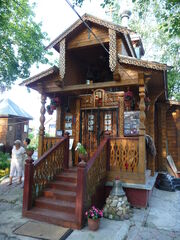
A traditional wooden house
Moscow Oblast has numerous therapeutic and recreational facilities located mainly in western, northwestern and northern parts, and also near Moscow. Of great importance for recreation are forests, which occupy over 40% of the region, as well as horticultural activities. The region has the highest number (over 1 million) of dachas with associated individual gardens. Also numerous are manor complexes, such as those in Abramtzevo, Muranovo, Ostafievo, historical cities (Vereya, Volokolamsk, Dmitrov, Zaraysk, Zvenigorod, Istra, Kolomna, Sergiyev Posad, Serpukhov, etc.), monasteries (Trinity Lavra of St. Sergius, Joseph-Volokolamsk Monastery, Savvino-Storozhevsky Monastery, Nikolo-Ugresh monastery, etc.), and museums (Chekhov museum in Melikhovo, Tchaikovsky museum in Klin, Serpukhov Historical and Art Museum, etc.).
Transport[]

The gateway to the Moscow Canal in Yakhroma

Moscow's North River Terminal or Rechnoy Vokzal
Moscow Oblast has a dense transport network, including roads, railways and waterways along the largest rivers, lakes and reservoirs. Land routes are radially diverging from Moscow and crossed by one railway and two highway rings. Neither railways nor roads, built for the most part many years ago, can cope with the steadily mounting traffic flows. About half of the roads are overloaded and three quarters do not meet modern requirements. Insufficient width of the roads and frequent repairs cause traffic jams.[30]
Moscow Oblast has the highest density of railways in Russia. Eleven major radial lines originate in Moscow and run through the Oblast; the total length of the railways reaches 2,700 km. Almost all railroads are electrified. The largest rail hubs are Orekhovo-Zuyevo and Bekasovo. Regular navigation is carried on the rivers Volga, Oka and Moscow, as well as on the Moscow Canal. Major river ports are in Serpukhov and Kolomna. Also well-developed is pipeline transport. There are two major oil lines, two natural gas rings and numerous radial lines connecting Moscow with the largest gas producing regions of the country.[31]
Moscow and Moscow Oblast have several international passenger airports, namely Sheremetyevo (with two terminals), Vnukovo, Domodedovo and Ostafyevo. Airport Bykovo is currently used for freight. The largest military airport is Chkalovsky (near Shchyolkovo) which can also process civilian cargos and flights.
Major highways of Moscow Oblast are as follows:
- Minsk highway (M1 "Belarus" Moscow – Belarus) (E101)
- Simferopol highway (M2 "Crimea") Moscow – Belgorod (E105)
- Kiev highway (M3 "Ukraine" Moscow – Kaluga – Bryansk – Kiev)
- Kashirskoye Highway (M4 "Don" Moscow – Rostov) (E115)
- Ryazan highway (M5 "Ural" Moscow – Chelyabinsk) (E30)
- Nizhny Novgorod highway (M7 "Volga" Moscow – Ufa) (E22)
- Kholmogory - Yaroslavl highway (M8 "Kholmogory" Moscow – Archangel) (E115)
- Novorizhskoe highway (M9 "Baltic" Moscow – Riga) (E22)
- Leningrad highway (M10 "Russia" Moscow – Tver – Novgorod – Saint Petersburg) (E105)
- Mozhaysk highway (A100 Moscow – Borodino)
- Kaluga highway (A101, Moscow – Troitsk – Obninsk – Kaluga)
- Schelkovskoe highway (A103 Moscow – Schelkovo – Chernogolovka)
- Dmitrovskoe (A104 Moscow – Dubna)
- Moscow Ring Small (A107)
- Moscow Large Ring (А108)
- Yegoryevsk highway (R105 Moscow – Kasimov)
- Pyatnitskoe highway (R111 Moscow – Solnechnogorsk)
- Rogachev highway (P113 Lobnya – Rogachevo (Dmitrov district))
- Nosovihinskoe highway (Moscow – Likino-Dulyovo)
- Warsaw highway (Moscow – Podolsk – Obninsk – Roslavl)
- Borovskoye highway (Moscow – Vnukovo)
- Rublyovo-Uspenskoe highway
- Dzerzhynsk highway (Dzerzhinsky – Kotelniki – Novoryazanskoye highway)
- Ostashkovskoye highway (Moscow – Mytischi)
Government and awards[]

The space Mission Control Center in Korolyov
Moscow Oblast was awarded three Orders of Lenin, on 3 January 1934, 17 December 1956 and 5 December 1966.
The highest executive organ is the Government of Moscow Oblast. Eighteen ministries act as the executive bodies of state authority.[32] The powers, tasks, functions and competence of the Government are defined by the Charter of the Moscow Region. Boris Gromov is the current Governor of the Moscow Oblast with the term of 5 years.[26] The Regional Duma of Moscow Oblast was formed on 12 December 1993. It consists of 50 deputies also serving a 5-year term.[26]
Science[]
Moscow Oblast has a high density of scientific research institutions, especially related to engineering and military technologies. The latter started developing in the region in 1930–1940s in Zhukovsky (aeronautical engineering), Klimovsk (development of small arms), Reutov (Missile Engineering), Fryazino (microwave electronics)[33] and Korolyov (space technology). They were later joined by famous centers for basic sciences in Troitsk, Chernogolovka (physics and chemistry), Dubna and Protvino (nuclear physics) and Pushchino (biology). Moscow Oblast hosts Mission Control Centers for spacecraft (in Korolyov) and military satellites (Krasnoznamensk), as well as a number of test sites.[34][35]
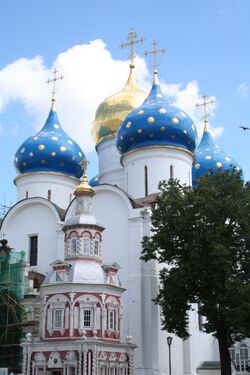
Trinity Cathedral of St. Sergi Lavra

The Cathedral of the Assumption in Dmitrov's kremlin (built in 1509–1523).
Culture and recreation[]

A traditional wooden house
Moscow Oblast has numerous therapeutic and recreational facilities located mainly in western, northwestern and northern parts, and also near Moscow. Of great importance for recreation are forests, which occupy over 40% of the region, as well as horticultural activities. The region has the highest number (over 1 million) of dachas with associated individual gardens. Also numerous are manor complexes, such as those in Abramtzevo, Muranovo, Ostafievo, historical cities (Vereya, Volokolamsk, Dmitrov, Zaraysk, Zvenigorod, Istra, Kolomna, Sergiyev Posad, Serpukhov, etc.), monasteries (Trinity Lavra of St. Sergius, Joseph-Volokolamsk Monastery, Savvino-Storozhevsky Monastery, Nikolo-Ugresh monastery, etc.), and museums (Chekhov museum in Melikhovo, Tchaikovsky museum in Klin, Serpukhov Historical and Art Museum, etc.).
Environment[]
Ecological situation in the Moscow Oblast is serious. The areas adjacent to Moscow, and industrial zones in the east and south-east regions are heavily polluted. Most contamination originates from emissions from Kashira and Shatura Power Stations and disposal of household and industrial waste. For example, the Timohovskaya dump is one of the largest in Europe; other objects of concern are aging oil storage tanks, and nuclear waste in the Sergiyevo-Posadsky District. Contamination level is highest in Moscow, Voskresensk and Klin, high in Dzerzhinsky, Kolomna, Mytishchi, Podolsk, Serpukhov, Schelkovo and Elektrostal, and low in Prioksko-Terrasny Biosphere Reserve.[36] The major contaminants are formaldehyde and phenol in Moscow; ammonia and hydrogen fluoride in Voskresensk; formaldehyde in Klin, Kolomna, Mytishchi and Podolsk, phenol in Serpukhov. The most polluted rivers are Moscow, Oka and Klyazma. In the Moscow area and in major cities (in particular, in Podolsk, Orekhovo-Zuyevo, Serpukhov, Lukhovitsy and Stupino) also heavily polluted are groundwaters.[36]
Population[]
The total population of the Oblast was growing as 6,628,107 (2006), 6,672,773 (2008), 6,732,629 (2009), 6,752,677 (2010). The average population density, at 147.4 inhabitants/km² (2010), is the largest in Russia, due to a high proportion of urban population (80.85% in 2010). The highest density occurs in and around Moscow (Lyubertsy, Balashikha, Khimki, Krasnogorsk, etc.) and the lowest – about 20 people/km² – is in the outlying areas of Lotoshinsky, Shakhovskoi, Mozhaysk and Meshchersk lowlands.[37]
| Nationalities represented by more than 1000 people in Moscow Oblast in 2002[38] | ||||||||||||||||||||||||||||||||||||||||||||||||||||||||
|
Administrative and municipal divisions[]
Administratively, the oblast is divided into 36 cities/towns under the oblast jurisdiction and 38 administrative districts, comprising 48 district-level towns, 70 urban-type settlements, and 6,123 rural localities.
As of 2010, Moscow Oblast is municipally subdivided into 38 urban okrugs and 36 municipal districts, which comprise 114 urban settlements and 193 rural settlements.
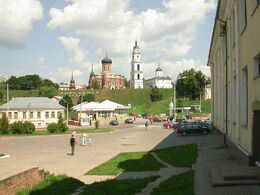
Center of Volokolamsk in 2003
The three largest cities of the oblast are Balashikha (192,800), Khimki (186,200), and Podolsk (182,400). Most other towns have ten to fifty thousand people. The smallest town is Vereya in Naro-Fominsky District with the population of 4,957 (2002 Census)[39]. Among the urban-type settlements, the largest is Nakhabino (33,000) followed by Tomilino (29,000). The oldest populated place in the oblast is Volokolamsk, first mentioned in 1135; slightly younger towns are Zvenigorod (1152), Dmitrov (1154), and Kolomna (1177).
The most intensive formation of cities occurred in 1938–1940. The youngest cities are Golitsyno, Kubinka and Moskovsky. They existed for quite some time, but obtained the city status only in 2004. Some recent cities separated from the other cities, such as Yubileyny and Peresvet. Although the city of Moscow is surrounded by Moscow Oblast and is considered its administrative center, it has a special territorial status – a city of federal significance (Constitution of Russia, article 65).
New projects have been announced at the beginning of the 21st century. One of them is Rublyovo-Arkhangelsk, which is designed for 30,000 inhabitants with high income and is called by the media the "city for millionaires".[40][41] Another is "Great Domodedovo, 30 km south of the Moscow Ring Road, which is designed for 450,000 residents.[42] The new city A101 was designed for 300,000 residents in 2009 and already began the sale of its land in Leninsky District. The city construction is planned to take 35 years.[43][44][45]
The housing stock of the oblast is approximately 125 million square meters. Almost all the houses are equipped with water supply, sewerage, gas,[46] central heating and hot water. However, the telephone network is underdeveloped in rural areas. In the competition for the most comfortable city of 2006 in the Moscow Oblast the winner was Kolomna followed by Balashikha (for cities with population over 100,000) and Vidnoye (<100,000) and then by Mytischi and Noginsk.
| Settlements with more than 20,000 inhabitants on 1 January 2009 | ||||||||||||||||||||||||||||||||||||||||||||||||||||||||||||||||||||||||||||||||||||||||||||||||||||||||||||||||||||||||||||||||||||||||
|
Sister regions[]
Bratislava, Slovakia.
Chuy Province, Kyrgyzstan.
 Île-de-France, France.
Île-de-France, France. Jiangsu, People's Republic of China.
Jiangsu, People's Republic of China.Ljubljana, Slovenia.
 Palembang, Indonesia.
Palembang, Indonesia.
External links[]
- (Russian) Official website of Moscow Oblast
- (Russian) Weather records for Moscow Oblast
| ||||||||||||||||||||||||||
References[]
- ^ "ПЛОТНОСТЬ НАСЕЛЕНИЯ И СИСТЕМА РАССЕЛЕНИЯ" (in Russian). 1999. http://www.sci.aha.ru/ATL/ra13a.htm.
- ^ Wagner, pp. 31–32
- ^ Wagner, p. 5
- ^ Wagner
- ^ Wagner, p. 15
- ^ Wagner, pp. 15–18
- ^ Wagner, p. 76
- ^ Wagner, pp. 73–76
- ^ Wagner, pp. 77–78
- ^ Wagner, p. 71
- ^ Site OAO Shaturtorf"
- ^ Myachkovo NA, Sorokin VN, Climate of Moscow Oblast, Moscow, 1991 (in Russian)
- ^ Lyubimova EL, Flora of Podmoskovie, Moscow, 1964
- ^ a b c Tourov SS, Wildlife of Podmoskovie, Moscow, 1961
- ^ History of Volokolamsk (in Russian)
- ^ History of Moscow Oblast moskvaobl.ru (in Russian)
- ^ a b Pages of History Moscow Oblast (in Russian)
- ^ a b History Official cite of Moscow Oblast (in Russian)
- ^ LG opened a plant in Podmoskovie 11 September 2006 (in Russian)
- ^ Economics (in Russian)
- ^ Russian Statistical Yearbook, 2005, average for each category over 1970–1980
- ^ Russian Statistical Yearbook, 2009, average over 2001–2008
- ^ Moscow transport hub – what will happen next, House, cottage, villa – all about low-rise construction. Technology, materials and equipment, people and companies
- ^ "Mostransgaz"
- ^ executive authorities
- ^ a b c d Charter of Moscow Oblast (in Russian)
- ^ Presidential Decree of 29 December 2003 No 1531 "On conferring the status of City of Science of the Russian Federation Fryazino Moscow Region
- ^ Rex Hall, David Shayler, Bert Vis (2005). Russia's cosmonauts: inside the Yuri Gagarin Training Center. Birkhäuser. p. 74. ISBN 0387218947. http://books.google.com/?id=zk_MkKERUokC&pg=PA74.
- ^ Brian Harvey (2007). The rebirth of the Russian space program: 50 years after Sputnik, new frontiers. pp. 253–258. ISBN 0387713549. http://books.google.com/?id=kmTz6Phf5WYC&pg=PA257.
- ^ Moscow transport hub – what will happen next, House, cottage, villa – all about low-rise construction. Technology, materials and equipment, people and companies
- ^ "Mostransgaz"
- ^ executive authorities
- ^ Presidential Decree of 29 December 2003 No 1531 "On conferring the status of City of Science of the Russian Federation Fryazino Moscow Region
- ^ Rex Hall, David Shayler, Bert Vis (2005). Russia's cosmonauts: inside the Yuri Gagarin Training Center. Birkhäuser. p. 74. ISBN 0387218947. http://books.google.com/?id=zk_MkKERUokC&pg=PA74.
- ^ Brian Harvey (2007). The rebirth of the Russian space program: 50 years after Sputnik, new frontiers. pp. 253–258. ISBN 0387713549. http://books.google.com/?id=kmTz6Phf5WYC&pg=PA257.
- ^ a b "Ecological portal Moscow Region". http://www.ecomo.ru/index.php?go=Pages&in=view&id=1961. Retrieved August 10, 2009.
- ^ Population of Russian Federation in 2009–2010
- ^ Данные Всероссийской переписи населения
- ^ "Численность населения России, субъектов Российской Федерации в составе федеральных округов, районов, городских поселений, сельских населённых пунктов – районных центров и сельских населённых пунктов с населением 3 тысячи и более человек [Population of Russia, its federal districts, federal subjects, districts, urban localities, rural localities—administrative centers, and rural localities with population of over 3,000]" (in Russian). Всероссийская перепись населения 2002 года (All-Russia Population Census of 2002). Federal State Statistics Service. May 21, 2004. http://www.perepis2002.ru/ct/doc/1_TOM_01_04.xls. Retrieved February 9, 2012.
- ^ New map of Moscow region, where the country is built parallel to the VIP -persons
- ^ Thirty thousand millionaires will move into a village near Moscow
- ^ Domodedovo: Krasnodar, near Moscow
- ^ Cities with the merchant scope (in Russian)
- ^ "Masshtab" sells lands of the project A-101 5 June 2005 (in Russian)
- ^ Economics Moscow traffic jams
- ^ GUP MO "Mosoblgaz"
| This page uses content from the English language Wikipedia. The original content was at Moscow Oblast. The list of authors can be seen in the page history. As with this Familypedia wiki, the content of Wikipedia is available under the Creative Commons License. |






